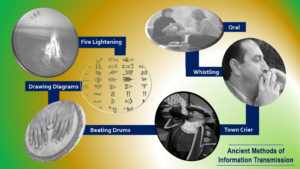Back to: Computer Studies JSS1
Welcome to class!
In today’s class, we shall be talking about drum beating as an ancient method of transmitting information. Please enjoy the class!
Ancient Methods of Transmitting Information – drum beating

Even before the invention of written language, humans found ingenious ways to share information over vast distances. One such method, still used today in some cultures, is drum beating. This seemingly simple act served as a complex communication system, allowing communities to transmit messages, warnings, and even complex stories.
Mechanisms of Drum Communication:

Drums as Instruments: Drums were crafted from various materials like wood, animal skin, and hollowed gourds. Their size, shape, and tension of the skin affected the sound produced, creating a diverse range of tones.
Codes and rhythms: Specific rhythms and sequences of drumbeats were assigned to convey specific messages. These codes could be standardized within communities, allowing for rapid and accurate communication.
Distance and terrain: Drumbeats could travel significant distances, particularly in open terrain. The rhythm could be modified to adjust for distance and ensure clarity.
Applications of Drum Communication:

Announcements and alerts: Drums were used to announce important events like village meetings, celebrations, or impending danger.
Military communication: Battle drums coordinated troop movements and communicated orders during warfare.
Storytelling and cultural preservation: Complex rhythms and patterns could encode stories, legends, and cultural knowledge, ensuring their transmission across generations.
Inter-tribal communication: Standardized drumming codes allowed communication between different communities, facilitating trade, alliances, and cultural exchange.
Unique Features of Drum Communication:
Accessibility: Drums were relatively easy to construct and use, making them accessible to a wide range of people.
Versatility: Drum communication could convey a diverse range of messages, from simple warnings to complex narratives.
Adaptability: Drum codes could evolve over time and adapt to the specific needs of different communities.
While modern technology has revolutionized communication, the legacy of drum communication lives on. In many indigenous cultures, drum beating remains an integral part of rituals, ceremonies, and cultural preservation. Furthermore, the study of ancient drumming practices offers valuable insights into the evolution of human communication and the creative potential of sound.
Drum beating, though a seemingly simple technology, represents a remarkable human achievement in communication. Its effectiveness, versatility, and cultural significance demonstrate the ingenuity and adaptability of our ancestors. By understanding this ancient method of information transmission, we gain a deeper appreciation for the human capacity for innovation and the enduring power of sound.
We have come to the end of today’s class. I hope you enjoyed the class!
In the next class, we shall be discussing Ancient Methods of Transmitting Information – fire lighting.
In case you require further assistance or have any questions, feel free to ask in the comment section below, and trust us to respond as soon as possible. Cheers!
Question Time:
- How did the construction of different drums affect the sound produced and its suitability for communication?
- Describe the various codes and rhythms used in drum communication and how their complexity varied across cultures.
- How did factors like distance, terrain, and weather impact the transmission of drum messages?
